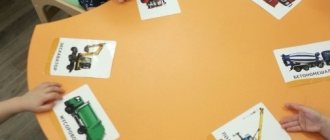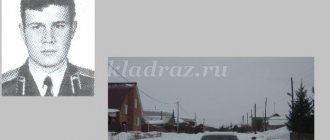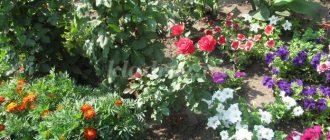Summary of the final lesson for children of the middle group on the topic: “Journey through the seasons”
Author: Belikova Vera Aleksandrovna, teacher of the MKDOU “Kalacheevsky kindergarten No. 1 of a general developmental type”
Explanatory note to the author's material
This lesson is intended for kindergarten teachers. Applies to the areas: “Knowledge”, “Communication”, “Creativity”. With the help of this lesson, children will consolidate their acquired knowledge about the natural world around them in an entertaining and playful way, learn to analyze, compare, make generalizations, and establish simple cause-and-effect relationships. The notes will help to conduct interesting activities that are developmental in nature and include various types of child activities. Promotes the formation of speech, memory, logical attention.
Summary of the final lesson for children of the middle group on the topic: “Journey through the seasons.”
Technological map of organized educational activities
Age group: secondary Educational areas: “Cognition”, “Communication”, “Creativity”. Section: Familiarization with the surrounding world. Topic: “Journey through the seasons.” Program objectives: 1. Educational: – the ability to perceive the image of each season; – enrich your vocabulary; – consolidate knowledge about wintering and migratory birds; – consolidate the ability to close a line into a ring and paint, repeating the outlines of the drawn figure. 2.Developing: – develop observation, interest in the surrounding nature, activity, attentiveness, reasoning skills; – develop an aesthetic perception of the beauty of nature; – develop creative imagination, ingenuity, ingenuity, fantasy and logical thinking. 3. Educational: – cultivate a love of nature; – bring children joy and pleasure from games; – cultivate the ability to listen carefully to the stories of your comrades and complement the answers. Preliminary work: memorizing poems, signs, proverbs about different seasons, looking at pictures about the seasons, observing on the street, on the site during walks throughout the year, drawing all the seasons. Vocabulary work: to activate in children’s speech words that characterize the seasons.
Progress of the lesson: 1. Motivational and incentive stage: Our ears are on top of our heads. The eyes are wide open. We listen, we remember, we don’t waste a minute. Guys, I have a magic scarf in my hands, with the help of it you can take a fascinating journey through the “Seasons”, you just have to cover all of you with this scarf. Do you want to go on an interesting and educational journey that will help us remember and compare all the seasons? 2. Organizational - search stage: (I cover the children with a scarf) The sound of transformation. - So, the journey begins, and you have to guess what time of year we are in. The melody “Sounds of Nature” plays. Snowstorm". – What time of year do you think we can hear such sounds outside the window? (if the children do not guess by sound, I give a hint, a riddle). I dusted the paths and decorated the windows. She gave joy to the children and gave them a sledding ride. (I take off my scarf and offer to sit at the tables) - That’s right, it’s winter, only at this time of year the blizzard howls outside the window. – Who can tell us how winter differs from other seasons? Let’s remember the signs of winter. Slide No. 1 A bear in a den, a squirrel in a hollow, a hedgehog under a stump, a hare. (with a click, a hollow, a snowdrift, a stump disappear) - The snow covered the whole earth with a white blanket and many animals hid under it from the frost. Look, there is a door on the tree here, I wonder who is hiding behind it? How do you think? - Let's check. That's right, the squirrel, she stocked up on nuts and mushrooms in advance and can now safely spend the winter in the hollow. But the snowdrift is also unusual, it’s probably someone’s house too? – What is the name of the bear’s house? -Who was hiding under the stump? - Yes, it's a hedgehog. He curled up and got ready to sleep. - And the hare, who runs through the forests and fields in winter, was given a new coat by winter. Who remembers which one? That's right - white. - Why does the bunny need a white fur coat? - Yes, guys, you can’t see him in the snow. (I suggest turning the chairs towards the table, I draw attention to the illustrations with birds lying in front of the children) - With the arrival of winter, life is hard for the birds. Not all of them stay with us for the winter. Name those birds that fly to warmer climes. - And now those birds that remain for the winter. - Everyone coped with the task, well done. The melody “Sounds of Nature” plays. A babbling stream." - Guys, you hear these sounds, it’s winter being replaced by another season. Loose snow melts in the sun, The wind plays in the branches, Birds' voices are louder, So it has come to us... Slide No. 2 (children make up a descriptive story using the pictures) - Let's make a short descriptive story about spring using the pictures? – That’s right, all nature comes to life in the spring. Everything around is green and singing. In the spring chaos, domestic animals have lost their cubs and cannot be found. Please come to me, let's help the kids, let's find their mothers. (children on the magnetic board make up pairs of animals and their babies) - Well done, guys. Not only birds, animals, and insects rejoice in spring, because all nature comes to life. Let's liven things up a little. Physical education To the song of the Barbarika group “The Little Animals Cried.” Jumping, jumping in the woods Gray balls of hares Jump-jump, jump-jump The little bunny stood on a stump He lined everyone up in order and began to show exercises. Once! Everyone walks in place. Two! They wave their hands together. Three! They sat down and stood up together. Everyone scratched behind the ear. We reached four. Five! They bent over and bent over. Six! Everyone stood in a row again, They walked like a squad. The melody “Sounds of Nature” plays. Birds singing” – After spring comes the next season. The sun is shining, the flowers are blooming, the berries are ripening, when does this happen? -Who can name this time of year? That's right - summer. – What changes occur in nature with the arrival of summer? Slide No. 3 Fruits - Correct. Summer brings us a lot of berries, vegetables and fruits. What are these guys? (pointing to the apple) What is it? It's red. And what's that? (pointing to the pear) this is a pear. Pear, what color? She's yellow. Where do fruits grow? – Look how many vegetables and fruits there are. Who will tell me all the fruits, and who will list the vegetables. – Why didn’t you name cherries, raspberries, strawberries, plums? - That's right, because they are berries. - Let's move on. I walked through the meadows, through the forests, through the fields. She prepared supplies for us, hid them in cellars, in bins, and said: Winter will come for me. - Of course it’s autumn. I suggest you remember the signs of autumn. – Look, my artist friend sent us illustrations of autumn, is everything on them correct? Slide No. 4 (Didactic game “What did the artist mix up?”) - And guys, your mothers make supplies for the winter in the fall, pickle cucumbers and tomatoes. Let's help mothers too. Sit down at the tables, let's draw tomatoes in a jar with a red lid, and cucumbers in a jar with a green lid. – What shape does a tomato have and a cucumber? – What color paint will we use when painting tomatoes and cucumbers? (children use cotton swabs to draw the outline of vegetables, then paint, repeating the outline of the drawn figure). - Well done guys, you all coped with the task. 3. Reflective - corrective stage: Well, our journey has ended. – What did you like most? – I really enjoyed traveling with you, today you were active, attentive, and smart. You have once again proven that you know a lot about the nature around you. Well done! -Well, in order for us to be in the group again, I need to cover all of you with a scarf. The melody of transformation sounds. - Well, here we are at home. Once again I want to thank you for such an interesting time spent with you.
Literature used: O.S. Ushakova, E.M. Strunina “Speech development in children 4-5 years old” Moscow 2007. A.A. Gribovskaya “Lesson in visual arts” Moscow 2009. I.A. Lykova “Fine arts in kindergarten. Middle group" Moscow 2010. T.N. Doronova “Visual activity and aesthetic development of a preschool child” Moscow 2006. . 9. A.A. Gribovskaya “Collective creativity of preschool children” Lesson notes Moscow 2004.
Summary of educational activities on cognition and speech development in the middle group. Seasons
Directly – educational activities in the field of “Cognitive and speech development” for children of the middle group on the topic “Seasons” with a presentation
Author: Vitskova Marina Viktorovna, teacher of the MBDOU “Kindergarten “Golden Fish” of the Astrakhan region, Chernoyarsk district. This material will be useful for educators when conducting conversations and educational activities on the topic: “Seasons” with children in the middle group Goal: to form an idea of the seasons. Objectives: - Continue to introduce children to the seasons and months. — To develop in children the ability to identify the signs of each season, to develop logical thinking, imagination, and the ability to restore logical relationships through riddles. Preliminary work: reading works, fairy tales, poems about the months, making proverbs, sayings and riddles about the seasons. Looking at illustrations depicting the seasons.
GCD
Educator. (holds a bell in his hand) Naughty little bell, form the guys in a circle. The guys gathered in a circle. On the left is a friend and on the right is a friend. Let's hold hands together and smile at each other. Educator. Well done, looked at each other and said hello. Children, I would like to start our event with you with a fairy tale. I know that you love fairy tales very much. Listen to the story carefully. And then we’ll find out what we’re going to talk about. Reading the fairy tale “The Four Seasons” Four seasons! And they are all so different, so necessary! Seasons - sunny, cloudy, murmuring, gloomy, singing, generous, snowy... So different, so necessary! The coldest is Winter, the most smiling is Spring, the most golden is Autumn. And the warmest thing is Summer! Educator. Guys, what is this fairy tale talking about? Children. About the seasons. Educator. Name them. What time of year do you like and why? 1st child. I like the season - winter. Because in winter there are a lot of games and entertainment. 2nd child. And I like summer. Because in the summer you can swim and sunbathe, and in the summer my parents and I love to travel. Educator. The fairy tale talks about the seasons, what each period of the year is famous for. Well done. Did a good job. Guys, tell me, what is this riddle about? Riddle Twelve brothers wander around each other, each other, do not bypass each other. Children. This is a riddle about months. Educator. That's right, this riddle is about the months of the year. Physical school is being held. How much snow has been covered! (children jump in a circle)
The rivers are all
(stretch their arms forward)
Bound with ice.
(squat)
In a snow cap
(stand up)
Every house.
(join hands in a “lock” above the head)
Frost on the trees
(tilt to the right, left hand above the head)
And on the wires.
(tilt to the left, right hand above head)
We are riding down the mountain -
(turn the body to the right and left)
Ah!
(clap their hands)
Guys, tell me, can you and I see all the seasons at once together?
Children. No Educator. Do you know a fairy tale in which time comes to visit, together? Children. There are twelve months in the fairy tale. Educator. Each season takes its course. There are four seasons and they repeat one after another. Children, what winter, spring, summer and autumn months do you know? Name them. (Children's answers) Educator. Now we'll play. A didactic game is being played “Tell me about what time of year the picture is” (Showing slides with images of the seasons) (Children’s answers) Educator. Well done boys. Children, tell me, what happens in winter? Children. In winter, the sun does not warm, lakes and rivers freeze, in winter it is cold and frosty, there is snow on the ground, there are few birds and animals, there are no leaves on the trees and there is snow. Educator. What happens in the spring? Children. In spring, the sun shines brightly, streams flow, birds fly in, green grass appears, buds swell on the trees, etc. Educator. What happens in the summer? Children. In summer it is warm and hot, the days are long and the nights are short, vegetables ripen in the gardens, fruits in the gardens, there are many leaves on the trees, beautiful flowers grow, animals have babies. Educator. What happens in the fall? Children. And in the fall, the grass turns yellow, leaves fall from the trees, it rains often, mushrooms appear in the forests, a cold wind blows, migratory birds fly to warmer climes, animals prepare for winter, people put on autumn clothes. Educator. Well done, right. You guys know everything. Fine. Educator. Guys, I really liked you all today. They answered questions well and talked interestingly about the seasons and months. Did you like it? Children. Yes. Educator. What interesting things did you learn? What did you like most? (Children's answers) Educator. They say that nature has no bad weather, and we will add that there are no bad seasons either.
Presentation on the topic: Seasons
We recommend watching:
Summary of educational activities for children with parents in the middle group. Do-it-yourself doll Summary of a speech therapy lesson for a preparatory group on the topic “Seasons” Mnemotables for children of the middle and senior groups “Seasons and their phenomena” Summary of GCD on cognition in the middle group on the topic “Transport”
Similar articles:
Fun trip for the older group. Seasons
Conversation in kindergarten in the preparatory group. Seasons in the forest
Summary of a lesson on the topic “Seasons” in the middle group of kindergarten
Activities about the seasons for children 5-7 years old
Outdoor games about the seasons in kindergarten for older children



